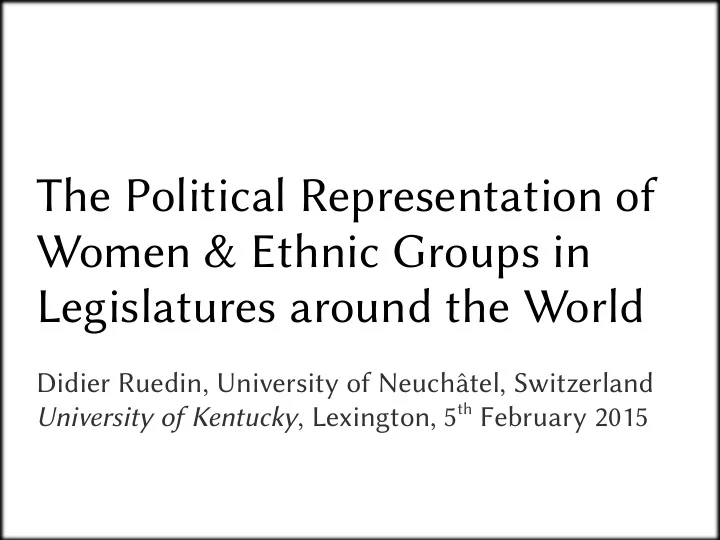

The Political Representation of Women & Ethnic Groups in Legislatures around the World Didier Ruedin, University of Neuchâtel, Switzerland University of Kentucky , Lexington, 5 th February 2015
Definitions ● Political Representation – Substantive representation – Descriptive representation R L R L R L L R R L L R R
Definitions ● Gender ● Ethnicity ● National legislature
Why Descriptive Representation? ● Legitimacy ● Substantive representation ● Uncrystallized interests ● Conflict reduction ● Status in society ● Symbolic value
Theoretical Frame Political Context Vote Legislature Citizens Salience Atuitudes Candidates Electoral System
Analytical Strategy ● Data on citizens and representatives – IPU (all 131 free/partly free countries) – Newly collected (2006) – 101 countries (115 countries) ● Level of representation – Country level ● Cross-sectional analysis ● Changes in variables
Measuring Representation n ∑ = ERS 1 1 = − Π − Π Z , i R , i 2 i 1
Women: Bivariate Associations ● PR systems – yes ● Party quotas – yes ● Legislative quotas – yes ● Political rights – yes ● Old democracies – yes ● Atuitudes – yes
Women: Atuitudes
Women: Multivariate
Ethnic Groups: Bivariate Associations ● PR systems – no ● Qvotas – not significant ● Political rights – no ● Old democracies – no ● Atuitudes – yes ● Heterogeneity – yes (control)
Ethnic Groups: Multivariate
First Summary Variable Women Ethnic Groups Electoral System Yes* No Qvotas Yes * (Yes) Political Rights Yes Yes * Old Democracy Yes No Atuitudes Yes ** Yes ** ** consistently; * in some models, not consistently; bivariate only
Relationship Between the Two ● Positive correlation – Political system – Culture ● Negative correlation – Trade-ofg between including women or ethnic minority groups ● Salience – Importance of social cleavage
Direct Relationship: Expectation ● High correlation ● Significant (p < 0.05) ● Sign: positive or negative
Direct Relationship: Result ● High correlation → r = 0.05 ● Significant (p < 0.05) → p > 0.1 ● Sign: positive or negative
Salience: Expectation Heterogeneous Homogeneous Women low high Ethnic high low Groups
Salience: Results Heterogeneous Homogeneous Women 0.30 0.34 Ethnic 0.63 0.28 Groups
Conclusion ● Difgerences between countries ● Atuitudes dominate ● Salience ● Qvotas – Implementation ● Electoral engineering ● Strong elites
Recommend
More recommend